Professional Engineering Management Assignment - Leadership Skills
VerifiedAdded on 2022/07/28
|6
|1637
|26
Report
AI Summary
This report addresses key aspects of professional engineering management, encompassing leadership, communication, and presentation skills. Task 1 defines steps for effective persuasion and negotiation, emphasizing preparation, discussion, and agreement. Task 2 outlines steps for managing effective group meetings, including establishing a purpose, agenda, and encouraging participation. Task 3 provides steps for delivering effective presentations, focusing on practice, assertiveness, audience engagement, and vocal techniques. Task 4 defines leadership, describes various leadership styles, and provides examples of transactional leadership. Finally, Task 5 explores coaching and mentoring disillusioned employees, offering strategies to address conflicts and improve collaboration within an organization. The report uses case studies and references relevant literature to support its findings.
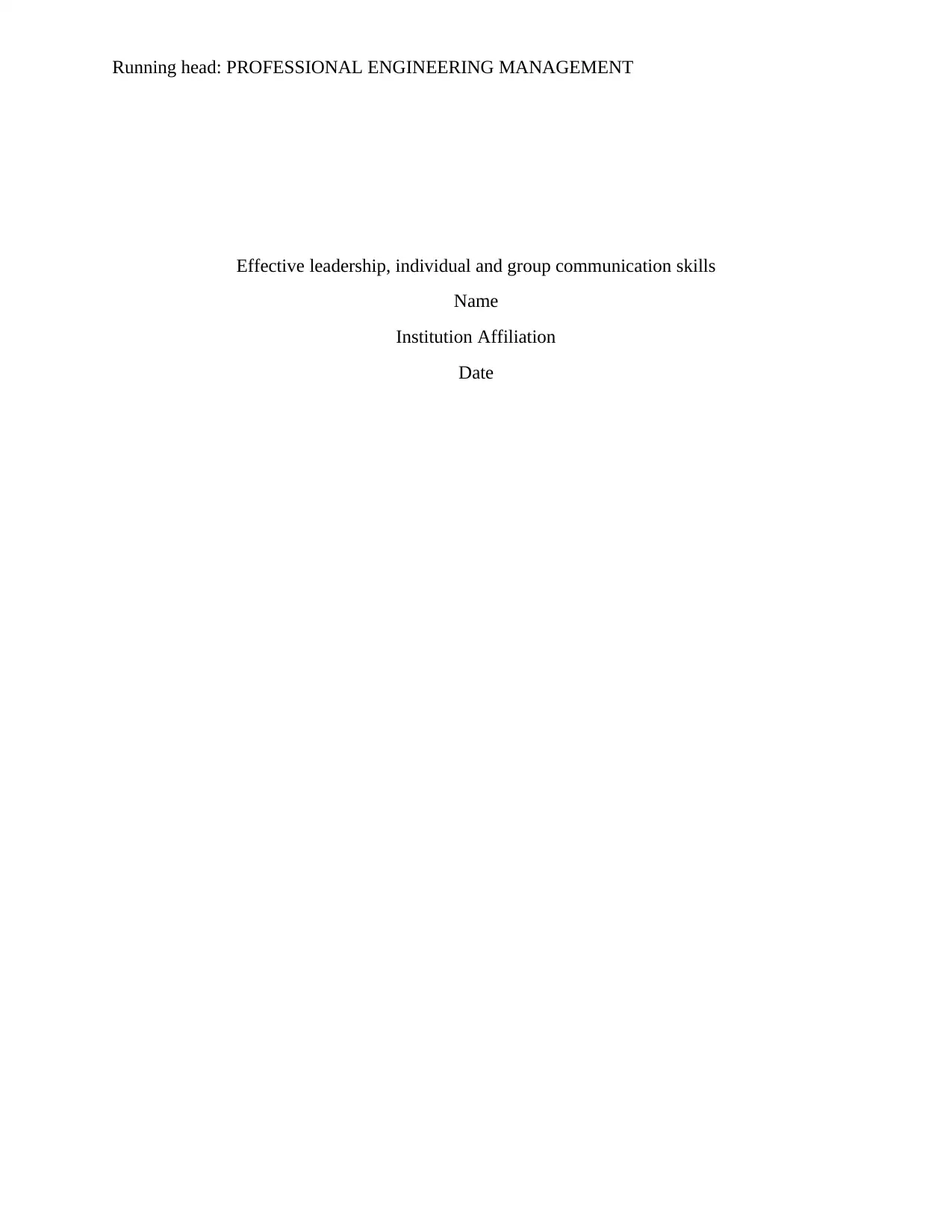
Running head: PROFESSIONAL ENGINEERING MANAGEMENT
Effective leadership, individual and group communication skills
Name
Institution Affiliation
Date
Effective leadership, individual and group communication skills
Name
Institution Affiliation
Date
Paraphrase This Document
Need a fresh take? Get an instant paraphrase of this document with our AI Paraphraser
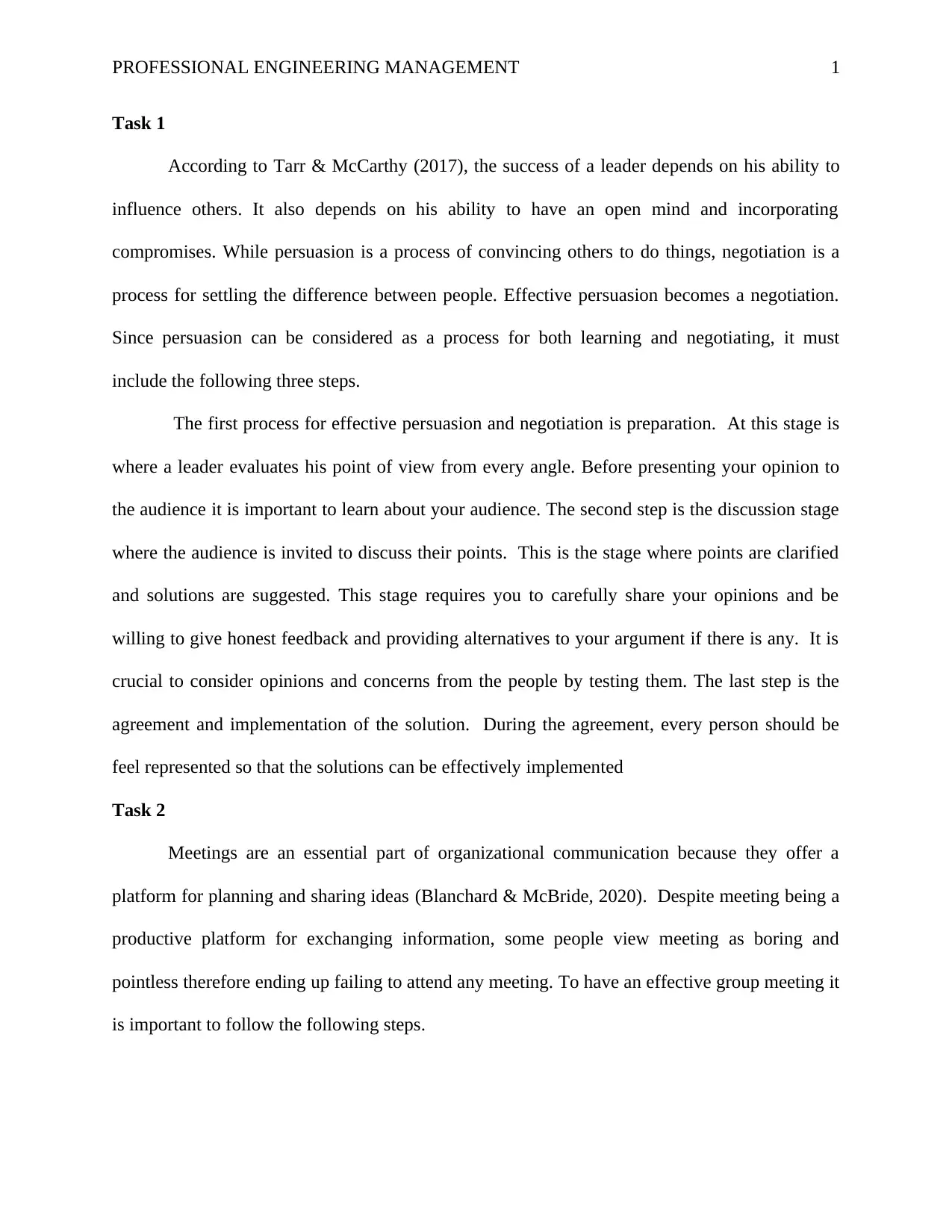
PROFESSIONAL ENGINEERING MANAGEMENT 1
Task 1
According to Tarr & McCarthy (2017), the success of a leader depends on his ability to
influence others. It also depends on his ability to have an open mind and incorporating
compromises. While persuasion is a process of convincing others to do things, negotiation is a
process for settling the difference between people. Effective persuasion becomes a negotiation.
Since persuasion can be considered as a process for both learning and negotiating, it must
include the following three steps.
The first process for effective persuasion and negotiation is preparation. At this stage is
where a leader evaluates his point of view from every angle. Before presenting your opinion to
the audience it is important to learn about your audience. The second step is the discussion stage
where the audience is invited to discuss their points. This is the stage where points are clarified
and solutions are suggested. This stage requires you to carefully share your opinions and be
willing to give honest feedback and providing alternatives to your argument if there is any. It is
crucial to consider opinions and concerns from the people by testing them. The last step is the
agreement and implementation of the solution. During the agreement, every person should be
feel represented so that the solutions can be effectively implemented
Task 2
Meetings are an essential part of organizational communication because they offer a
platform for planning and sharing ideas (Blanchard & McBride, 2020). Despite meeting being a
productive platform for exchanging information, some people view meeting as boring and
pointless therefore ending up failing to attend any meeting. To have an effective group meeting it
is important to follow the following steps.
Task 1
According to Tarr & McCarthy (2017), the success of a leader depends on his ability to
influence others. It also depends on his ability to have an open mind and incorporating
compromises. While persuasion is a process of convincing others to do things, negotiation is a
process for settling the difference between people. Effective persuasion becomes a negotiation.
Since persuasion can be considered as a process for both learning and negotiating, it must
include the following three steps.
The first process for effective persuasion and negotiation is preparation. At this stage is
where a leader evaluates his point of view from every angle. Before presenting your opinion to
the audience it is important to learn about your audience. The second step is the discussion stage
where the audience is invited to discuss their points. This is the stage where points are clarified
and solutions are suggested. This stage requires you to carefully share your opinions and be
willing to give honest feedback and providing alternatives to your argument if there is any. It is
crucial to consider opinions and concerns from the people by testing them. The last step is the
agreement and implementation of the solution. During the agreement, every person should be
feel represented so that the solutions can be effectively implemented
Task 2
Meetings are an essential part of organizational communication because they offer a
platform for planning and sharing ideas (Blanchard & McBride, 2020). Despite meeting being a
productive platform for exchanging information, some people view meeting as boring and
pointless therefore ending up failing to attend any meeting. To have an effective group meeting it
is important to follow the following steps.
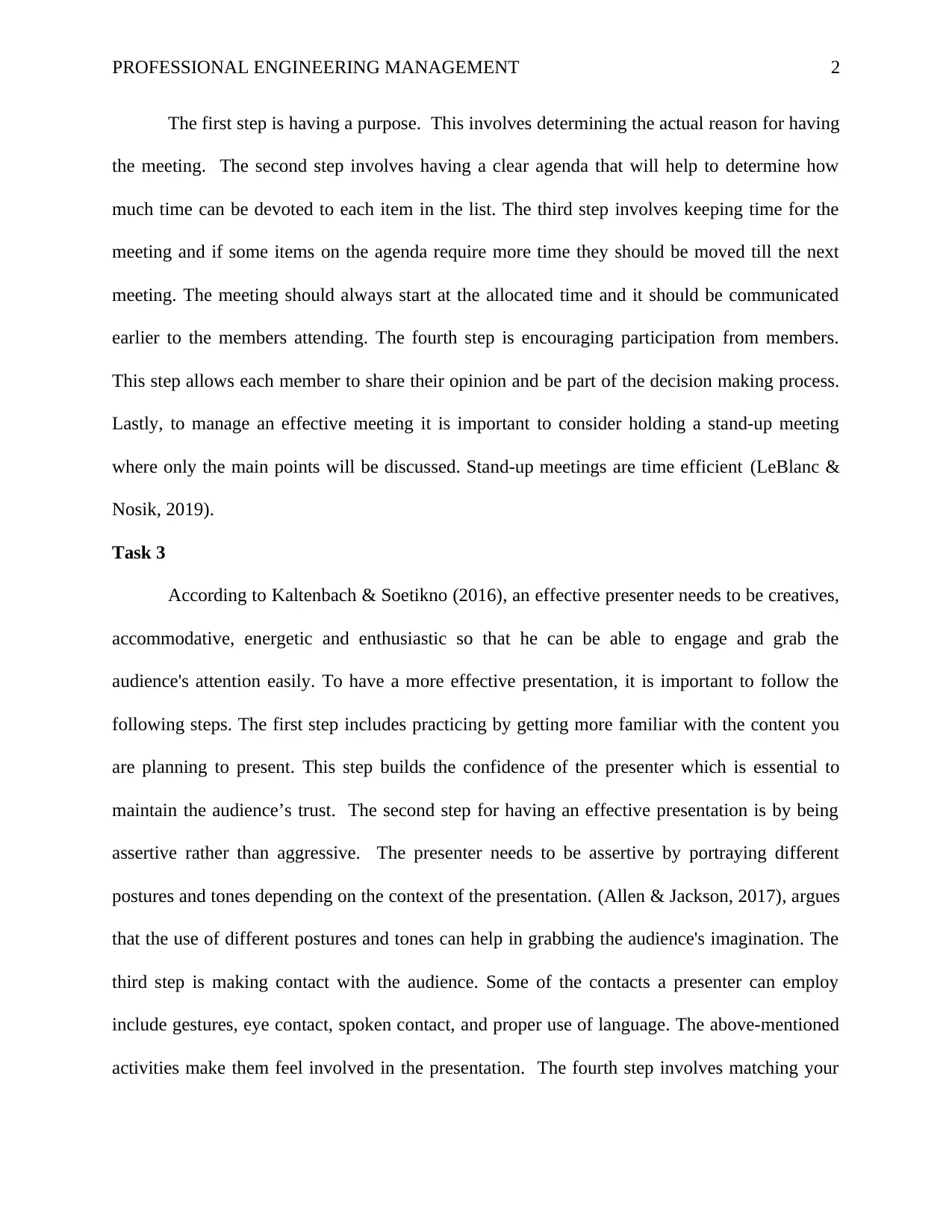
PROFESSIONAL ENGINEERING MANAGEMENT 2
The first step is having a purpose. This involves determining the actual reason for having
the meeting. The second step involves having a clear agenda that will help to determine how
much time can be devoted to each item in the list. The third step involves keeping time for the
meeting and if some items on the agenda require more time they should be moved till the next
meeting. The meeting should always start at the allocated time and it should be communicated
earlier to the members attending. The fourth step is encouraging participation from members.
This step allows each member to share their opinion and be part of the decision making process.
Lastly, to manage an effective meeting it is important to consider holding a stand-up meeting
where only the main points will be discussed. Stand-up meetings are time efficient (LeBlanc &
Nosik, 2019).
Task 3
According to Kaltenbach & Soetikno (2016), an effective presenter needs to be creatives,
accommodative, energetic and enthusiastic so that he can be able to engage and grab the
audience's attention easily. To have a more effective presentation, it is important to follow the
following steps. The first step includes practicing by getting more familiar with the content you
are planning to present. This step builds the confidence of the presenter which is essential to
maintain the audience’s trust. The second step for having an effective presentation is by being
assertive rather than aggressive. The presenter needs to be assertive by portraying different
postures and tones depending on the context of the presentation. (Allen & Jackson, 2017), argues
that the use of different postures and tones can help in grabbing the audience's imagination. The
third step is making contact with the audience. Some of the contacts a presenter can employ
include gestures, eye contact, spoken contact, and proper use of language. The above-mentioned
activities make them feel involved in the presentation. The fourth step involves matching your
The first step is having a purpose. This involves determining the actual reason for having
the meeting. The second step involves having a clear agenda that will help to determine how
much time can be devoted to each item in the list. The third step involves keeping time for the
meeting and if some items on the agenda require more time they should be moved till the next
meeting. The meeting should always start at the allocated time and it should be communicated
earlier to the members attending. The fourth step is encouraging participation from members.
This step allows each member to share their opinion and be part of the decision making process.
Lastly, to manage an effective meeting it is important to consider holding a stand-up meeting
where only the main points will be discussed. Stand-up meetings are time efficient (LeBlanc &
Nosik, 2019).
Task 3
According to Kaltenbach & Soetikno (2016), an effective presenter needs to be creatives,
accommodative, energetic and enthusiastic so that he can be able to engage and grab the
audience's attention easily. To have a more effective presentation, it is important to follow the
following steps. The first step includes practicing by getting more familiar with the content you
are planning to present. This step builds the confidence of the presenter which is essential to
maintain the audience’s trust. The second step for having an effective presentation is by being
assertive rather than aggressive. The presenter needs to be assertive by portraying different
postures and tones depending on the context of the presentation. (Allen & Jackson, 2017), argues
that the use of different postures and tones can help in grabbing the audience's imagination. The
third step is making contact with the audience. Some of the contacts a presenter can employ
include gestures, eye contact, spoken contact, and proper use of language. The above-mentioned
activities make them feel involved in the presentation. The fourth step involves matching your
⊘ This is a preview!⊘
Do you want full access?
Subscribe today to unlock all pages.

Trusted by 1+ million students worldwide
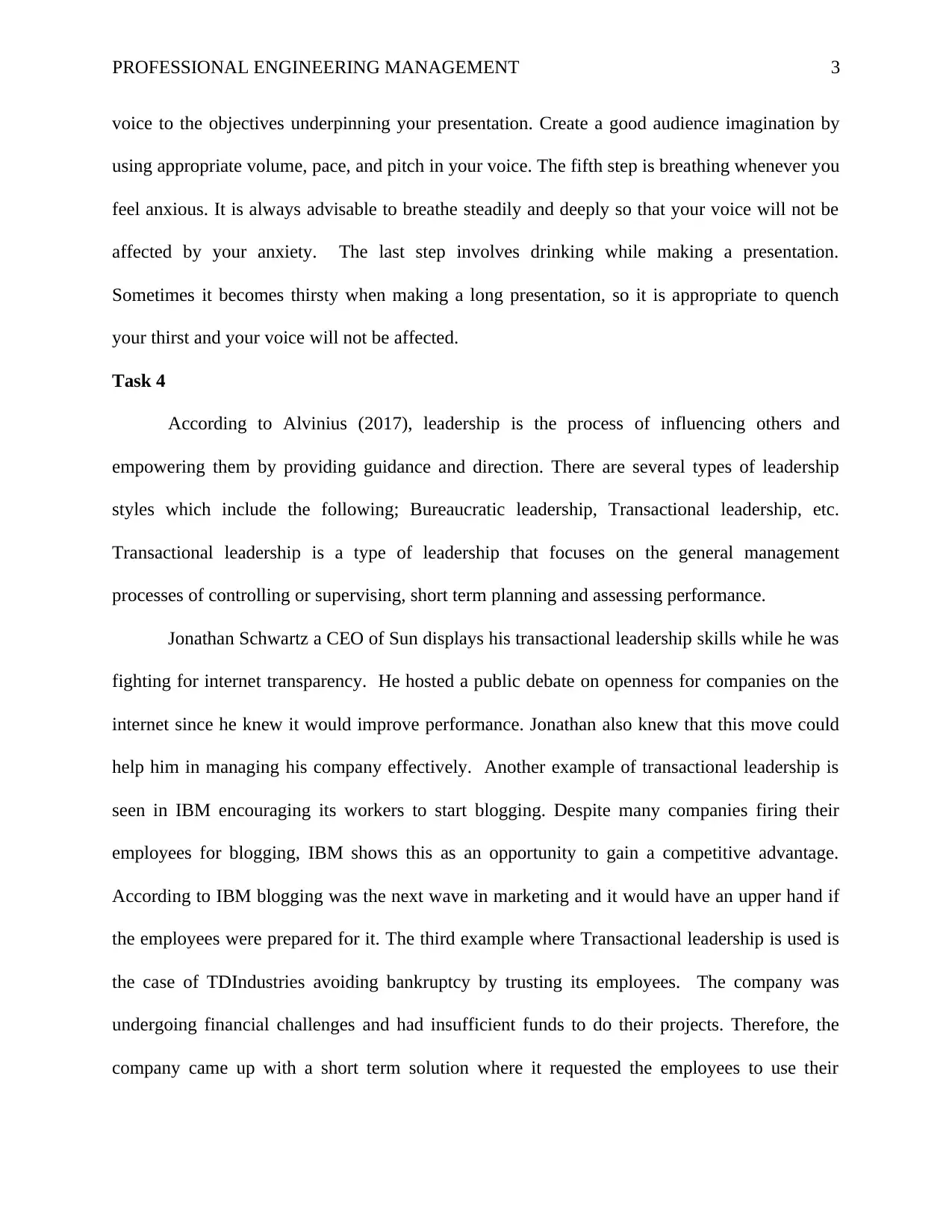
PROFESSIONAL ENGINEERING MANAGEMENT 3
voice to the objectives underpinning your presentation. Create a good audience imagination by
using appropriate volume, pace, and pitch in your voice. The fifth step is breathing whenever you
feel anxious. It is always advisable to breathe steadily and deeply so that your voice will not be
affected by your anxiety. The last step involves drinking while making a presentation.
Sometimes it becomes thirsty when making a long presentation, so it is appropriate to quench
your thirst and your voice will not be affected.
Task 4
According to Alvinius (2017), leadership is the process of influencing others and
empowering them by providing guidance and direction. There are several types of leadership
styles which include the following; Bureaucratic leadership, Transactional leadership, etc.
Transactional leadership is a type of leadership that focuses on the general management
processes of controlling or supervising, short term planning and assessing performance.
Jonathan Schwartz a CEO of Sun displays his transactional leadership skills while he was
fighting for internet transparency. He hosted a public debate on openness for companies on the
internet since he knew it would improve performance. Jonathan also knew that this move could
help him in managing his company effectively. Another example of transactional leadership is
seen in IBM encouraging its workers to start blogging. Despite many companies firing their
employees for blogging, IBM shows this as an opportunity to gain a competitive advantage.
According to IBM blogging was the next wave in marketing and it would have an upper hand if
the employees were prepared for it. The third example where Transactional leadership is used is
the case of TDIndustries avoiding bankruptcy by trusting its employees. The company was
undergoing financial challenges and had insufficient funds to do their projects. Therefore, the
company came up with a short term solution where it requested the employees to use their
voice to the objectives underpinning your presentation. Create a good audience imagination by
using appropriate volume, pace, and pitch in your voice. The fifth step is breathing whenever you
feel anxious. It is always advisable to breathe steadily and deeply so that your voice will not be
affected by your anxiety. The last step involves drinking while making a presentation.
Sometimes it becomes thirsty when making a long presentation, so it is appropriate to quench
your thirst and your voice will not be affected.
Task 4
According to Alvinius (2017), leadership is the process of influencing others and
empowering them by providing guidance and direction. There are several types of leadership
styles which include the following; Bureaucratic leadership, Transactional leadership, etc.
Transactional leadership is a type of leadership that focuses on the general management
processes of controlling or supervising, short term planning and assessing performance.
Jonathan Schwartz a CEO of Sun displays his transactional leadership skills while he was
fighting for internet transparency. He hosted a public debate on openness for companies on the
internet since he knew it would improve performance. Jonathan also knew that this move could
help him in managing his company effectively. Another example of transactional leadership is
seen in IBM encouraging its workers to start blogging. Despite many companies firing their
employees for blogging, IBM shows this as an opportunity to gain a competitive advantage.
According to IBM blogging was the next wave in marketing and it would have an upper hand if
the employees were prepared for it. The third example where Transactional leadership is used is
the case of TDIndustries avoiding bankruptcy by trusting its employees. The company was
undergoing financial challenges and had insufficient funds to do their projects. Therefore, the
company came up with a short term solution where it requested the employees to use their
Paraphrase This Document
Need a fresh take? Get an instant paraphrase of this document with our AI Paraphraser
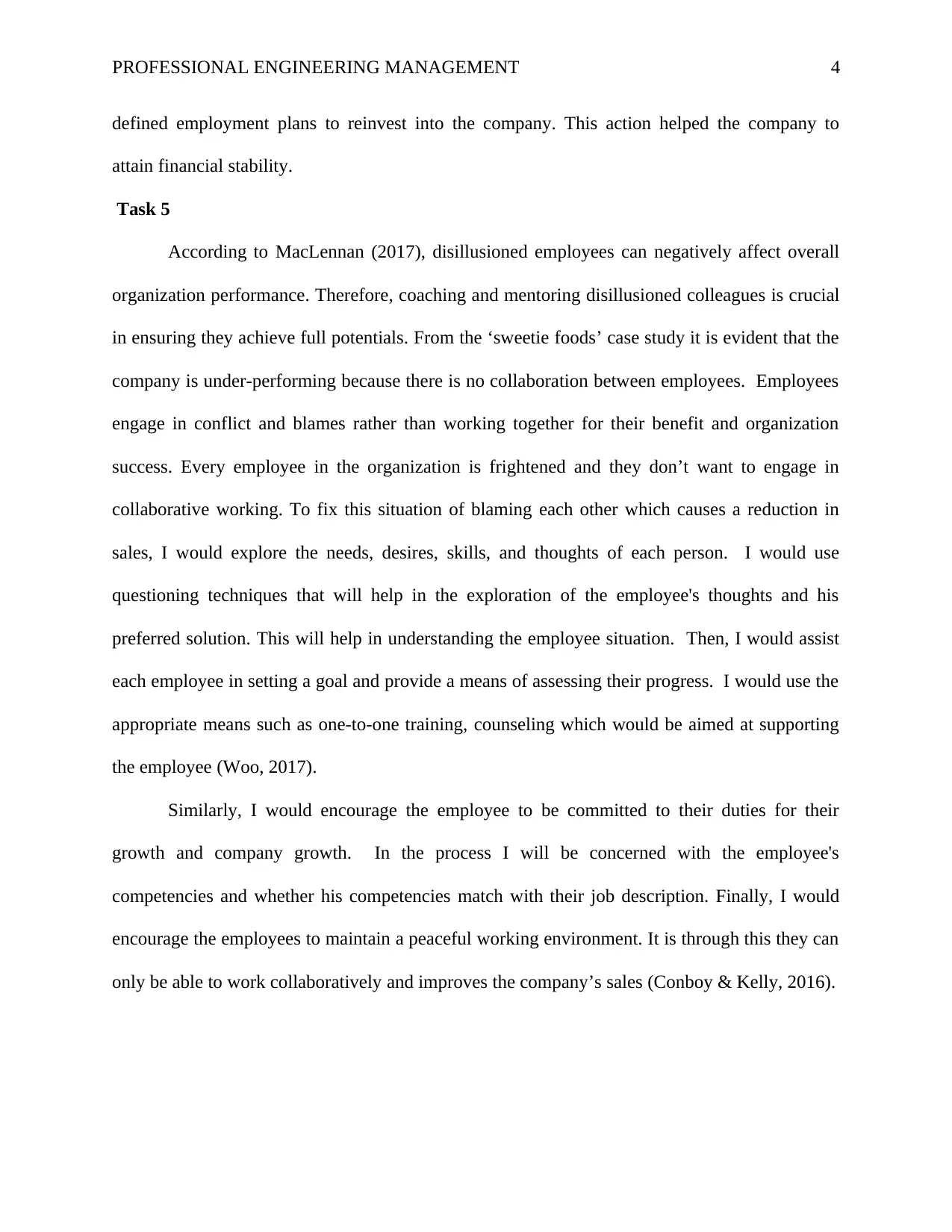
PROFESSIONAL ENGINEERING MANAGEMENT 4
defined employment plans to reinvest into the company. This action helped the company to
attain financial stability.
Task 5
According to MacLennan (2017), disillusioned employees can negatively affect overall
organization performance. Therefore, coaching and mentoring disillusioned colleagues is crucial
in ensuring they achieve full potentials. From the ‘sweetie foods’ case study it is evident that the
company is under-performing because there is no collaboration between employees. Employees
engage in conflict and blames rather than working together for their benefit and organization
success. Every employee in the organization is frightened and they don’t want to engage in
collaborative working. To fix this situation of blaming each other which causes a reduction in
sales, I would explore the needs, desires, skills, and thoughts of each person. I would use
questioning techniques that will help in the exploration of the employee's thoughts and his
preferred solution. This will help in understanding the employee situation. Then, I would assist
each employee in setting a goal and provide a means of assessing their progress. I would use the
appropriate means such as one-to-one training, counseling which would be aimed at supporting
the employee (Woo, 2017).
Similarly, I would encourage the employee to be committed to their duties for their
growth and company growth. In the process I will be concerned with the employee's
competencies and whether his competencies match with their job description. Finally, I would
encourage the employees to maintain a peaceful working environment. It is through this they can
only be able to work collaboratively and improves the company’s sales (Conboy & Kelly, 2016).
defined employment plans to reinvest into the company. This action helped the company to
attain financial stability.
Task 5
According to MacLennan (2017), disillusioned employees can negatively affect overall
organization performance. Therefore, coaching and mentoring disillusioned colleagues is crucial
in ensuring they achieve full potentials. From the ‘sweetie foods’ case study it is evident that the
company is under-performing because there is no collaboration between employees. Employees
engage in conflict and blames rather than working together for their benefit and organization
success. Every employee in the organization is frightened and they don’t want to engage in
collaborative working. To fix this situation of blaming each other which causes a reduction in
sales, I would explore the needs, desires, skills, and thoughts of each person. I would use
questioning techniques that will help in the exploration of the employee's thoughts and his
preferred solution. This will help in understanding the employee situation. Then, I would assist
each employee in setting a goal and provide a means of assessing their progress. I would use the
appropriate means such as one-to-one training, counseling which would be aimed at supporting
the employee (Woo, 2017).
Similarly, I would encourage the employee to be committed to their duties for their
growth and company growth. In the process I will be concerned with the employee's
competencies and whether his competencies match with their job description. Finally, I would
encourage the employees to maintain a peaceful working environment. It is through this they can
only be able to work collaboratively and improves the company’s sales (Conboy & Kelly, 2016).
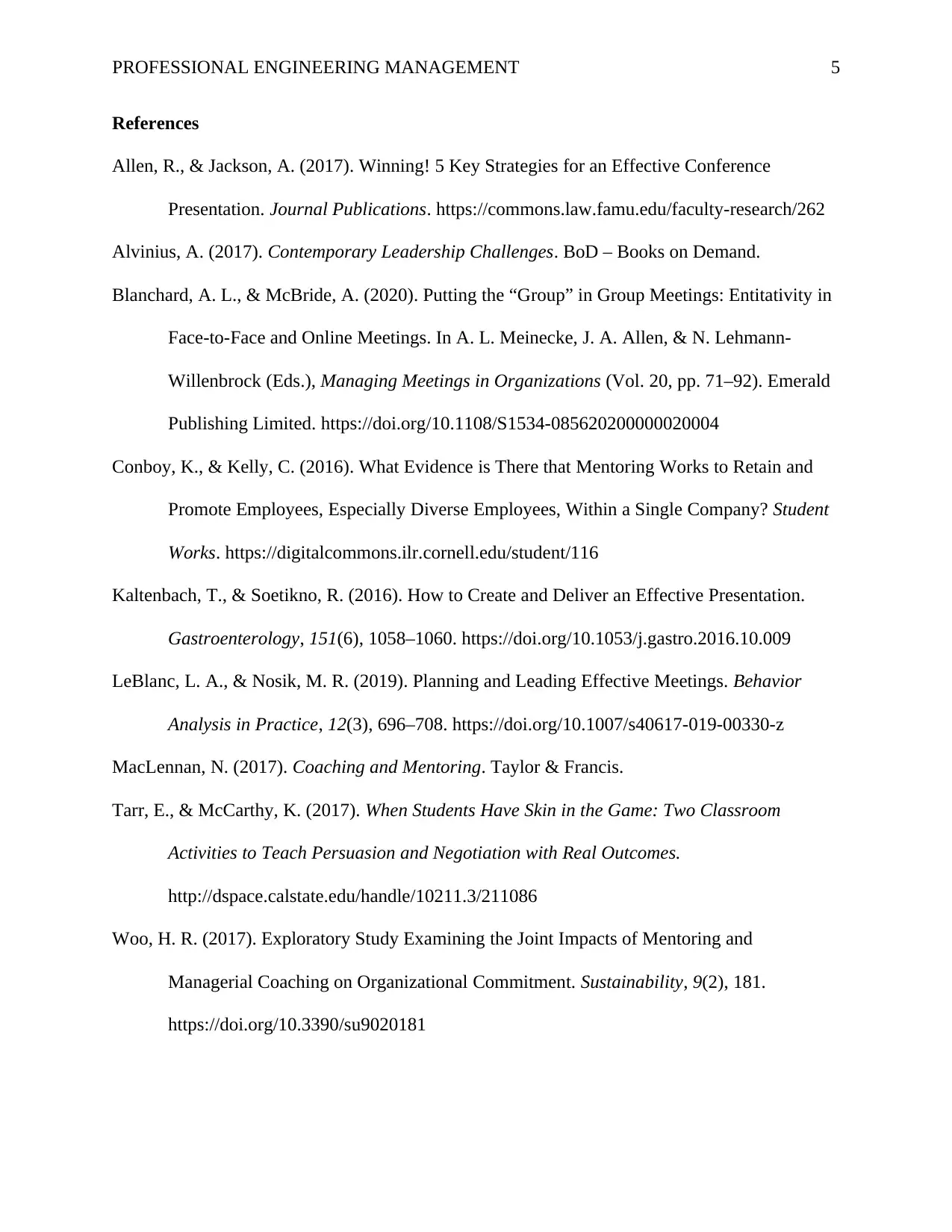
PROFESSIONAL ENGINEERING MANAGEMENT 5
References
Allen, R., & Jackson, A. (2017). Winning! 5 Key Strategies for an Effective Conference
Presentation. Journal Publications. https://commons.law.famu.edu/faculty-research/262
Alvinius, A. (2017). Contemporary Leadership Challenges. BoD – Books on Demand.
Blanchard, A. L., & McBride, A. (2020). Putting the “Group” in Group Meetings: Entitativity in
Face-to-Face and Online Meetings. In A. L. Meinecke, J. A. Allen, & N. Lehmann-
Willenbrock (Eds.), Managing Meetings in Organizations (Vol. 20, pp. 71–92). Emerald
Publishing Limited. https://doi.org/10.1108/S1534-085620200000020004
Conboy, K., & Kelly, C. (2016). What Evidence is There that Mentoring Works to Retain and
Promote Employees, Especially Diverse Employees, Within a Single Company? Student
Works. https://digitalcommons.ilr.cornell.edu/student/116
Kaltenbach, T., & Soetikno, R. (2016). How to Create and Deliver an Effective Presentation.
Gastroenterology, 151(6), 1058–1060. https://doi.org/10.1053/j.gastro.2016.10.009
LeBlanc, L. A., & Nosik, M. R. (2019). Planning and Leading Effective Meetings. Behavior
Analysis in Practice, 12(3), 696–708. https://doi.org/10.1007/s40617-019-00330-z
MacLennan, N. (2017). Coaching and Mentoring. Taylor & Francis.
Tarr, E., & McCarthy, K. (2017). When Students Have Skin in the Game: Two Classroom
Activities to Teach Persuasion and Negotiation with Real Outcomes.
http://dspace.calstate.edu/handle/10211.3/211086
Woo, H. R. (2017). Exploratory Study Examining the Joint Impacts of Mentoring and
Managerial Coaching on Organizational Commitment. Sustainability, 9(2), 181.
https://doi.org/10.3390/su9020181
References
Allen, R., & Jackson, A. (2017). Winning! 5 Key Strategies for an Effective Conference
Presentation. Journal Publications. https://commons.law.famu.edu/faculty-research/262
Alvinius, A. (2017). Contemporary Leadership Challenges. BoD – Books on Demand.
Blanchard, A. L., & McBride, A. (2020). Putting the “Group” in Group Meetings: Entitativity in
Face-to-Face and Online Meetings. In A. L. Meinecke, J. A. Allen, & N. Lehmann-
Willenbrock (Eds.), Managing Meetings in Organizations (Vol. 20, pp. 71–92). Emerald
Publishing Limited. https://doi.org/10.1108/S1534-085620200000020004
Conboy, K., & Kelly, C. (2016). What Evidence is There that Mentoring Works to Retain and
Promote Employees, Especially Diverse Employees, Within a Single Company? Student
Works. https://digitalcommons.ilr.cornell.edu/student/116
Kaltenbach, T., & Soetikno, R. (2016). How to Create and Deliver an Effective Presentation.
Gastroenterology, 151(6), 1058–1060. https://doi.org/10.1053/j.gastro.2016.10.009
LeBlanc, L. A., & Nosik, M. R. (2019). Planning and Leading Effective Meetings. Behavior
Analysis in Practice, 12(3), 696–708. https://doi.org/10.1007/s40617-019-00330-z
MacLennan, N. (2017). Coaching and Mentoring. Taylor & Francis.
Tarr, E., & McCarthy, K. (2017). When Students Have Skin in the Game: Two Classroom
Activities to Teach Persuasion and Negotiation with Real Outcomes.
http://dspace.calstate.edu/handle/10211.3/211086
Woo, H. R. (2017). Exploratory Study Examining the Joint Impacts of Mentoring and
Managerial Coaching on Organizational Commitment. Sustainability, 9(2), 181.
https://doi.org/10.3390/su9020181
⊘ This is a preview!⊘
Do you want full access?
Subscribe today to unlock all pages.

Trusted by 1+ million students worldwide
1 out of 6
Related Documents
Your All-in-One AI-Powered Toolkit for Academic Success.
+13062052269
info@desklib.com
Available 24*7 on WhatsApp / Email
![[object Object]](/_next/static/media/star-bottom.7253800d.svg)
Unlock your academic potential
Copyright © 2020–2025 A2Z Services. All Rights Reserved. Developed and managed by ZUCOL.





